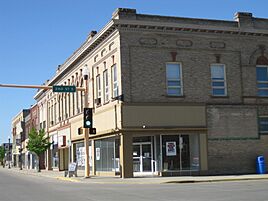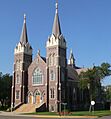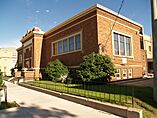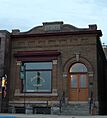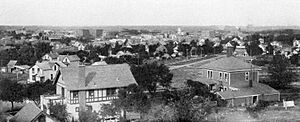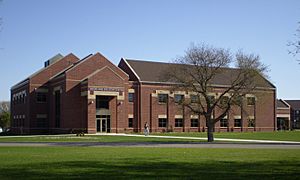Jamestown, North Dakota facts for kids
Quick facts for kids
Jamestown, North Dakota
|
||
|---|---|---|
|
Downtown Jamestown, 2009
Alfred E. Dickey Free Library
Seiler Building
|
||
|
||
| Nickname(s):
Pride of the Prairie
|
||
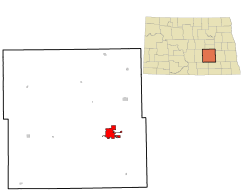
Location of Jamestown in Stutsman County, North Dakota
|
||
| Country | United States | |
| State | North Dakota | |
| County | Stutsman | |
| Settled | 1871 | |
| Founded | 1872 | |
| Incorporated | 1883 | |
| Government | ||
| • Type | Council–manager | |
| Area | ||
| • City | 13.356 sq mi (34.592 km2) | |
| • Land | 13.296 sq mi (34.437 km2) | |
| • Water | 0.060 sq mi (0.156 km2) | |
| Elevation | 1,427 ft (435 m) | |
| Population
(2020)
|
||
| • City | 15,849 | |
| • Estimate
(2023)
|
15,691 | |
| • Density | 1,180.00/sq mi (455.61/km2) | |
| • Urban | 15,207 | |
| • Metro | 21,392 (US: 498th) | |
| Time zone | UTC–6 (Central (CST)) | |
| • Summer (DST) | UTC–5 (CDT) | |
| ZIP Codes |
58401, 58402, 58405
|
|
| Area code(s) | 701 | |
| FIPS code | 38-40580 | |
| GNIS feature ID | 1036100 | |
| Highways | ND 20, US 52, I 94, US 281 | |
| Sales tax | 7.5% | |
Jamestown is a city in Stutsman County, North Dakota, United States. It's known as the "Pride of the Prairie." About 15,849 people lived there in 2020. This makes it the ninth largest city in North Dakota. Jamestown was officially started in 1883. It is also home to the University of Jamestown.
Contents
History of Jamestown
In 1871, a team from the Northern Pacific Railroad set up camp. They were building a new railway line across the James River. The next year, in 1872, the United States Army built Fort Seward. This small fort protected the railroad crossing. It had about 120 soldiers. The fort closed after five years in 1877.
The railroad, however, stayed. It built a repair yard that was a big part of the city's jobs until the 1960s. Jamestown was named by General Thomas Rosser. He named it after Jamestown, Virginia. The city became official in 1883. In 1873, Stutsman County was formed. Jamestown became its main city, called the county seat.
Jamestown's Geography and Climate
Jamestown is located where the James River and Pipestem Creek meet. The city covers about 12.87 square miles (33.3 square kilometers). Most of this area is land.
Weather in Jamestown
Jamestown has a typical northern prairie climate. Summers can be warm and humid. Winters are very cold. Snowfall can start as early as October.
| Climate data for Jamestown, North Dakota (North Dakota State Hospital) 1991–2020 normals, extremes 1881–present | |||||||||||||
|---|---|---|---|---|---|---|---|---|---|---|---|---|---|
| Month | Jan | Feb | Mar | Apr | May | Jun | Jul | Aug | Sep | Oct | Nov | Dec | Year |
| Record high °F (°C) | 56 (13) |
65 (18) |
80 (27) |
99 (37) |
107 (42) |
107 (42) |
118 (48) |
107 (42) |
107 (42) |
95 (35) |
78 (26) |
67 (19) |
118 (48) |
| Mean maximum °F (°C) | 42.2 (5.7) |
43.9 (6.6) |
59.3 (15.2) |
76.8 (24.9) |
86.4 (30.2) |
91.2 (32.9) |
94.1 (34.5) |
93.0 (33.9) |
89.2 (31.8) |
79.7 (26.5) |
59.5 (15.3) |
44.6 (7.0) |
96.6 (35.9) |
| Mean daily maximum °F (°C) | 18.4 (−7.6) |
23.0 (−5.0) |
35.9 (2.2) |
52.7 (11.5) |
66.9 (19.4) |
76.5 (24.7) |
81.6 (27.6) |
80.3 (26.8) |
71.2 (21.8) |
54.8 (12.7) |
37.5 (3.1) |
23.6 (−4.7) |
51.9 (11.1) |
| Daily mean °F (°C) | 9.4 (−12.6) |
13.6 (−10.2) |
26.3 (−3.2) |
41.0 (5.0) |
54.7 (12.6) |
65.2 (18.4) |
70.1 (21.2) |
68.0 (20.0) |
58.7 (14.8) |
44.0 (6.7) |
28.4 (−2.0) |
15.6 (−9.1) |
41.2 (5.1) |
| Mean daily minimum °F (°C) | 0.4 (−17.6) |
4.2 (−15.4) |
16.7 (−8.5) |
29.4 (−1.4) |
42.5 (5.8) |
53.9 (12.2) |
58.5 (14.7) |
55.7 (13.2) |
46.2 (7.9) |
33.3 (0.7) |
19.3 (−7.1) |
7.6 (−13.6) |
30.6 (−0.8) |
| Mean minimum °F (°C) | −21.3 (−29.6) |
−17.8 (−27.7) |
−5.7 (−20.9) |
15.1 (−9.4) |
29.7 (−1.3) |
43.7 (6.5) |
48.6 (9.2) |
45.8 (7.7) |
31.8 (−0.1) |
18.1 (−7.7) |
1.7 (−16.8) |
−14.3 (−25.7) |
−23.9 (−31.1) |
| Record low °F (°C) | −41 (−41) |
−42 (−41) |
−29 (−34) |
−8 (−22) |
8 (−13) |
25 (−4) |
35 (2) |
29 (−2) |
15 (−9) |
−8 (−22) |
−27 (−33) |
−40 (−40) |
−42 (−41) |
| Average precipitation inches (mm) | 0.50 (13) |
0.46 (12) |
0.74 (19) |
1.22 (31) |
3.44 (87) |
3.62 (92) |
3.59 (91) |
2.28 (58) |
2.24 (57) |
1.89 (48) |
0.52 (13) |
0.62 (16) |
21.12 (536) |
| Average snowfall inches (cm) | 11.4 (29) |
7.4 (19) |
6.5 (17) |
2.5 (6.4) |
0.4 (1.0) |
0.0 (0.0) |
0.0 (0.0) |
0.0 (0.0) |
0.0 (0.0) |
1.9 (4.8) |
4.2 (11) |
11.8 (30) |
46.1 (117) |
| Average precipitation days (≥ 0.01 in) | 5.7 | 5.8 | 5.3 | 7.6 | 12.1 | 12.6 | 10.6 | 8.2 | 7.5 | 7.4 | 5.5 | 6.3 | 94.6 |
| Average snowy days (≥ 0.1 in) | 4.7 | 4.8 | 3.4 | 0.9 | 0.2 | 0.0 | 0.0 | 0.0 | 0.0 | 0.8 | 2.6 | 5.5 | 22.9 |
| Source: NOAA | |||||||||||||
People of Jamestown
| Historical population | |||
|---|---|---|---|
| Census | Pop. | %± | |
| 1880 | 393 | — | |
| 1890 | 2,296 | 484.2% | |
| 1900 | 2,853 | 24.3% | |
| 1910 | 4,358 | 52.8% | |
| 1920 | 6,627 | 52.1% | |
| 1930 | 8,187 | 23.5% | |
| 1940 | 8,790 | 7.4% | |
| 1950 | 10,697 | 21.7% | |
| 1960 | 15,163 | 41.8% | |
| 1970 | 15,385 | 1.5% | |
| 1980 | 16,280 | 5.8% | |
| 1990 | 15,571 | −4.4% | |
| 2000 | 15,527 | −0.3% | |
| 2010 | 15,427 | −0.6% | |
| 2020 | 15,849 | 2.7% | |
| 2023 (est.) | 15,691 | 1.7% | |
| U.S. Decennial Census 2020 Census |
|||
In 2022, there were about 6,771 homes in Jamestown. Each home had about 2 people living in it. The average household income was $53,389. About 14.9% of the people lived below the poverty line. About 62% of people had jobs. Most adults (90.5%) had a high school diploma. About 22.1% had a college degree or higher.
Most people in Jamestown reported their background as English (95.9%). Other backgrounds included Spanish (1.7%), Indo-European (1.9%), and Asian (0.3%). The average age in the city was 38.8 years old.
Jamestown's Population in 2020
The 2020 census showed 15,849 people living in Jamestown. There were 6,709 households. The city had 7,493 housing units.
The population was mostly White (89.62%). Other groups included African American (2.81%) and Native American (1.78%). About 3.35% of the population was Hispanic or Latino.
About 17.7% of residents were under 18 years old. About 20.5% were 65 years or older.
Jamestown's Economy
Jamestown has a strong economy. It focuses on making things with high accuracy. It also has businesses for food processing, farming, and retail. Some important companies based here include Sunward Steel and ACI. Other big employers are Cavendish Farms and UTC Aerospace Systems. There are also places to repair trucks and heavy equipment.
The Jamestown Stutsman Development Corporation helps new businesses grow. They work on four industrial parks. These parks include Bloom Business Park and Spiritwood Energy Park.
Arts, Culture, and Fun in Jamestown
Fun Places to Visit

The Jamestown Reservoir is a great place for fun. It has three connected artificial lakes. They are 12 miles long. You can enjoy watersports and fishing here.
Jamestown has two 18-hole golf courses. They are Hillcrest Golf Course and Jamestown Country Club. The Jamestown Civic Center hosts concerts and sports games. It is also home to the North Dakota Sports Hall of Fame. Jack Brown Stadium is a historic baseball park.
There are also two disc golf courses. One is an 18-hole course in Klaus Park. The other is a 27-hole championship course on an island in the Jamestown Reservoir.
The Jamestown Arts Center is in downtown. It has art shows all year. It also has a community theater and art classes. You can find a ceramics studio and an outdoor Art Park there.
Jamestown is famous for the World's Largest Buffalo. This is a huge 26-foot tall sculpture of an American bison. You can also visit the National Buffalo Museum nearby.
Education in Jamestown
Schools for Kids and Teens
Jamestown Public Schools serves the city. It has five elementary schools, one middle school, and one high school. There is also an alternative high school. Louis L'Amour Elementary School is named after the famous writer Louis L'Amour. He was born in Jamestown.
There are also two private elementary schools. Saint John's Academy is a Catholic school for grades K-6. Hillcrest School is a Seventh-day Adventist school.
Colleges and Universities
The University of Jamestown is a private college. It was started by the Presbyterian Church. It is on the north side of town. In 2021, about 908 students attended. It is known as a top college in the region. It has been open to both boys and girls since it started in 1883.
The college first opened in September 1886. It closed for a short time due to money problems. But it reopened in September 1909. This happened as more people moved to the state. Jamestown College became a successful school. It was the only college between Fargo, ND, and Missoula, MT, for a long time.
Special Education Support
The Anne Carlsen Center North Campus is on the northwest side of the city. It helps children with severe disabilities. It is a privately funded school. In 2024, the Anne Carlsen Center moved to a new campus in southwest Jamestown. It is a leading center for helping and teaching children with special needs.
Media in Jamestown
Newspapers
The local daily newspaper is the Jamestown Sun.
Television Channels
| Channel | Digital Channel |
Call sign | Affiliation | Owner | City | Notes |
|---|---|---|---|---|---|---|
| 2 | K02DD | ABC | Forum Communications | Jamestown | (rebroadcasts WDAY Fargo) | |
| 7 (RF 7) | KJRR | Fox | Red River Broadcasting | Jamestown | (rebroadcasts KVRR Fargo) | |
| 19 (RF 20) | KJRE | PBS | Prairie Public Broadcasting | Ellendale |
Radio Stations
AM Radio Stations
| AM radio stations | |||||
|---|---|---|---|---|---|
| Frequency | Call sign | Name | Format | Owner | City |
| 600 AM | KSJB | – | Classic country | Chesterman Communications | Jamestown |
| 1400 AM | KQDJ | Dakota Country Radio | Full service | Ingstad Family Media | Jamestown |
FM Radio Stations
| FM radio stations | ||||||
|---|---|---|---|---|---|---|
| Frequency | Call sign | Name | Format | Owner | Target city/market | City of license |
| 88.1 FM | KJKR | Jimmie Knight Radio | Campus radio | University of Jamestown | Jamestown | Jamestown |
| 89.1 FM | K214BX | – | Christian K-Love (WAFR) translator |
K-Love | Jamestown | Jamestown |
| 89.9 FM | K214BX | – | Christian AFR (WAFR) translator |
American Family Association | Jamestown | Jamestown |
| 90.7 FM | KCBJ | – | Christian | Fargo Baptist Church / Cornerstone Baptist Church | Jamestown | Jamestown |
| 91.5 FM | KPRJ | – | Prairie Public/NPR News/classical music |
Prairie Public Broadcasting | Jamestown | Jamestown |
| 93.3 FM | KSJZ | Mix 93.3 | Hot Adult Contemporary | Chesterman Communications | Jamestown | Jamestown |
| 95.5 FM | KYNU | Big Dog Country | Country | i3G Media | Jamestown/Valley City | Jamestown |
| 97.1 FM | K246AM | Ted FM | Classic Hits KRVX-HD2 translator |
i3G Media | Jamestown | Jamestown |
| 98.3 FM | KXGT | Thunder 106.1 & 98.3 (simulcast of KQLX-FM) | Country | i3G Media | Jamestown | Carrington |
| 101.1 FM | KQDJ | Q101 | Top 40 (CHR) | i3G Media | Jamestown/Valley City | Valley City |
| 103.1 FM | KRVX | 103.1 The Raven | Rock | i3G Media | Jamestown/Valley City | Wimbledon |
| 107.1 FM | K296HH | Jamestown 107.1 | Soft AC KQDJ-AM translator |
i3G Media | Jamestown | Jamestown |
Transportation in Jamestown
Air Travel
Jamestown Regional Airport offers flights to Devils Lake, North Dakota and Denver, Colorado. It also handles private chartered flights.
Main Roads
Local and City Transit
Jefferson Lines provides bus service to other cities. For local travel, James River Public Transit offers a "dial-a-ride" service. You can call them to arrange a ride. The fare is $2.50. They operate Monday to Thursday from 6:15 AM to 6:00 PM. On Friday, they run until 7:00 PM. On Saturday, it's 8:00 AM to 6:00 PM. On Sunday, it's 8:00 AM to 1:00 PM.
Famous People from Jamestown
- James Harvey Brown (1906–1995), a city council member and judge.
- Anne Carlsen (1915–2002), an educator and advocate for people with disabilities. The Anne Carlsen Center is named after her.
- Alf Clausen, a composer for TV shows like The Simpsons.
- Edward P. J. Corbett, an English professor.
- William E. DePuy, a U.S. Army general.
- Alfred Dickey (1846–1901), the first Lieutenant Governor of North Dakota.
- Willis Downs, a Medal of Honor recipient.
- Roy S. Durstine (1886–1962), co-founder of a big advertising agency.
- Darin Erstad, a former Major League Baseball player.
- Michael John Fitzmaurice, a Medal of Honor recipient from the Vietnam War.
- John Grabinger, a North Dakota Senator.
- Travis Hafner, a former Major League Baseball player.
- Richard Hieb, an astronaut.
- George W. Johnson, a university president.
- Anton Klaus, a mayor of Green Bay, Wisconsin.
- John Knauf, a judge on the North Dakota Supreme Court.
- Louis L'Amour, a famous author.
- Peggy Lee, a jazz singer and composer.
- Lewis Marquardt, a South Dakota state representative.
- Barbara McClintock, a children's book illustrator.
- Jim Ramstad, a Minnesota politician.
- Floyd Roberts, winner of the 1938 Indianapolis 500.
- Ronda Rousey, a famous fighter and wrestler.
- Myrna Sharlow, an opera singer.
- Rodney Stark, a sociologist of religion.
- Shadoe Stevens, a radio personality.
- Mya Taylor, an actress.
- Charles F. Thompson, a U.S. Army major general.
- Harley Venton, an actor.
- Charles Lewis Camp, a paleontologist and zoologist.
See also
 In Spanish: Jamestown (Dakota del Norte) para niños
In Spanish: Jamestown (Dakota del Norte) para niños


